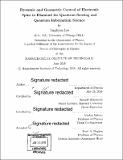Dynamic and geometric control of electronic spins in diamond for quantum sensing and quantum information science
Author(s)
Lee, Junghyun, Ph. D. Massachusetts Institute of Technology
DownloadFull printable version (20.45Mb)
Other Contributors
Massachusetts Institute of Technology. Department of Physics.
Advisor
Ronald Walsworth and Vladan Vuletic.
Terms of use
Metadata
Show full item recordAbstract
In recent years, the nitrogen-vacancy (NV) color center in diamond, electronic spin defects embedded in a solid-state system, has emerged as a promising platform for quantum sensing and quantum information science in ambient temperature. Its capability of robust but high-precision spin control allows the NV center to be not only a useful atomic-scale magnetic field sensor but also an attractive building block for quantum processors. In this dissertation, I present novel schemes to dynamically and geometrically control NV spins for improved magnetic field sensing and studies of spin dynamics. First, dynamic NV phase control is synchronized with an external oscillating magnetic field, enabling single and ensemble NV AC magnetometry spectral resolution approaching sub-mHz. This protocol allows NV spins to sense an AC field spectral resolution beyond the inverse of NV spin lifetime. Also, dynamic control via dressed states of the NV spin is shown to provide effective tuning of the dipolar coupling between spins. In strongly interacting NV spin ensembles, this robust tool can be used to change the interaction dynamics. Second, geometric phase control is used to sense an external static magnetic field, improving detection sensitivity and field range. Especially, geometric phase magnetometry provides a 100-fold improvement of field range compared to conventional Ramsey magnetometry. Moreover, geometric phase control is used to observe the change of a topological state via measuring the Chern number, showing that an NV spin can serve as a tool for simple quantum simulations. Finally, I discuss the possibilities of combining the presented schemes with other quantum techniques to realize further interesting applications in future work.
Description
Thesis: Ph. D., Massachusetts Institute of Technology, Department of Physics, 2018. Cataloged from PDF version of thesis. Includes bibliographical references (pages 163-172).
Date issued
2018Department
Massachusetts Institute of Technology. Department of PhysicsPublisher
Massachusetts Institute of Technology
Keywords
Physics.